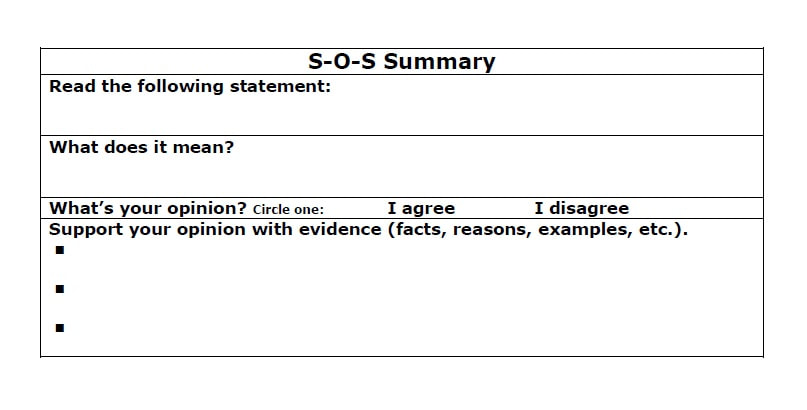44. S-O-S STRATEGY (Writing, Discussion, Questioning)
Description: Give students a statement (S) in order to reflect on what it means, give their opinion (O), and support (S) it with evidence.
Application: S-O-S Strategy can be used as an informal assessment, document-based question (DBQ) practice, essay and/or discussion starter.
Process: Create numerous statements that are relevant to the topic of study. Hand out the S-O-S Summary Sheet (Addendum below) to each student. Write a statement on the board or if there are many statements, have the summary sheet prepared before class, and get students to copy the statement. Have students fill in the summary sheet by listing facts, data, reasons, and examples from gleaned information. Allow five minutes for this process to occur and have students then use sheets for the foundations/scaffolds of DBQ response or essay.
Description: Give students a statement (S) in order to reflect on what it means, give their opinion (O), and support (S) it with evidence.
Application: S-O-S Strategy can be used as an informal assessment, document-based question (DBQ) practice, essay and/or discussion starter.
Process: Create numerous statements that are relevant to the topic of study. Hand out the S-O-S Summary Sheet (Addendum below) to each student. Write a statement on the board or if there are many statements, have the summary sheet prepared before class, and get students to copy the statement. Have students fill in the summary sheet by listing facts, data, reasons, and examples from gleaned information. Allow five minutes for this process to occur and have students then use sheets for the foundations/scaffolds of DBQ response or essay.
Reference, graphics, and/or for more information:
44. S-O-S Strategy
Dodge, J. (2009) 25 Quick Formative Assessments for a Differentiated Classroom. Scholastic Teaching Resource.
44. S-O-S Strategy
Dodge, J. (2009) 25 Quick Formative Assessments for a Differentiated Classroom. Scholastic Teaching Resource.

